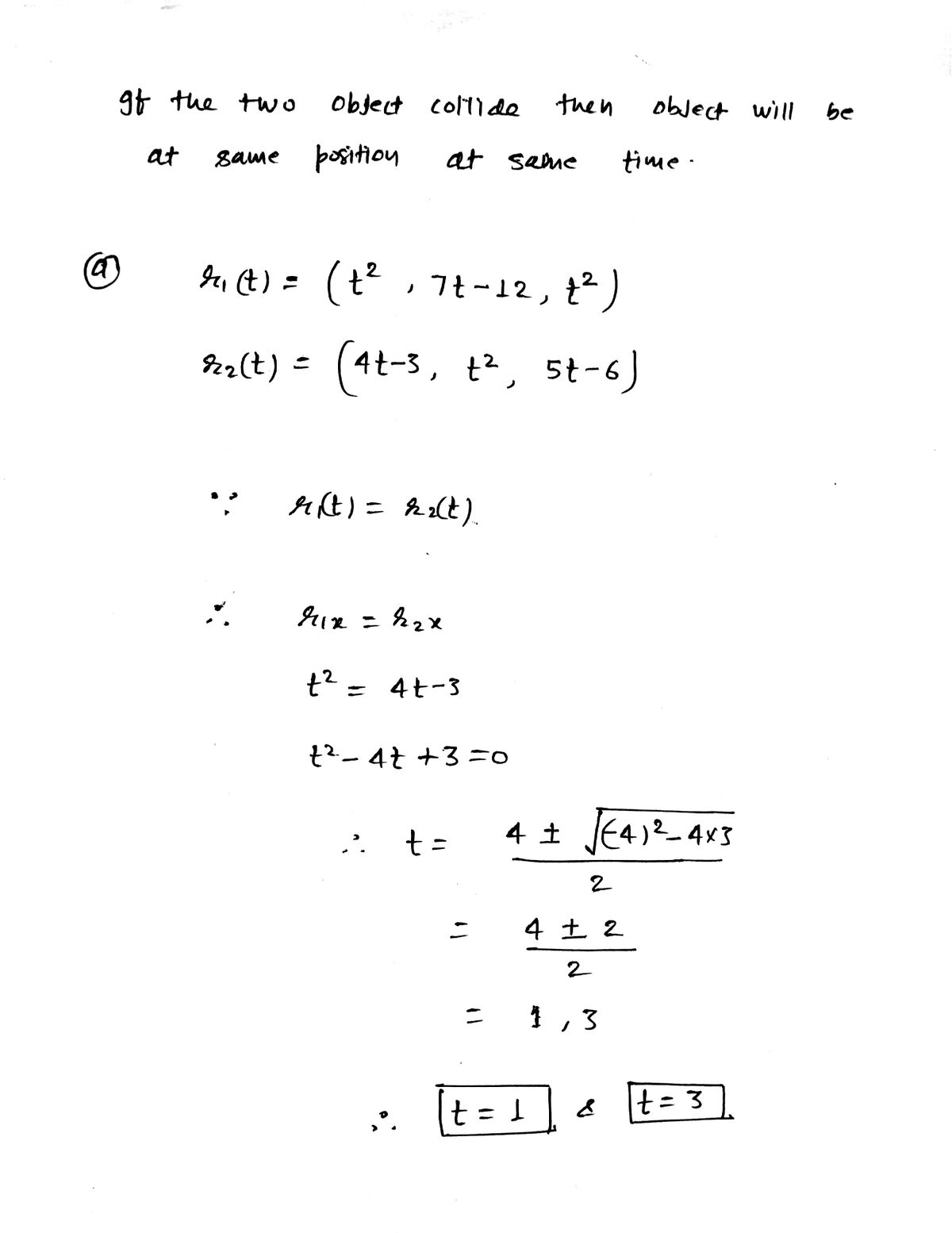4. If two objects travel through space along two curves, it's often important to know whether they will collide. (Will a missile hit its moving target? Will two aircraft collide?) The curves might intersect, but we need to know whether the objects are in the same position at the same time. Suppose the following vector functions represent the trajectories of two particles. Do these particles collide? If not, do their paths intersect? (Assume t≥ 0.) (a) r₁(t) = (t², 7t 12, t²) and r₂(t) = (4t-3, t², 5t - 6) (b) p₁(t) = ti+t²j+t³k and p2(t) = (1 + 2t)i + (1 + 6t)j + (1 + 14t)k
4. If two objects travel through space along two curves, it's often important to know whether they will collide. (Will a missile hit its moving target? Will two aircraft collide?) The curves might intersect, but we need to know whether the objects are in the same position at the same time. Suppose the following vector functions represent the trajectories of two particles. Do these particles collide? If not, do their paths intersect? (Assume t≥ 0.) (a) r₁(t) = (t², 7t 12, t²) and r₂(t) = (4t-3, t², 5t - 6) (b) p₁(t) = ti+t²j+t³k and p2(t) = (1 + 2t)i + (1 + 6t)j + (1 + 14t)k
College Physics
11th Edition
ISBN:9781305952300
Author:Raymond A. Serway, Chris Vuille
Publisher:Raymond A. Serway, Chris Vuille
Chapter1: Units, Trigonometry. And Vectors
Section: Chapter Questions
Problem 1CQ: Estimate the order of magnitude of the length, in meters, of each of the following; (a) a mouse, (b)...
Related questions
Concept explainers
Topic Video
Question

Transcribed Image Text:4. If two objects travel through space along two curves, it's often important to know whether
they will collide. (Will a missile hit its moving target? Will two aircraft collide?) The
curves might intersect, but we need to know whether the objects are in the same position
at the same time. Suppose the following vector functions represent the trajectories of
two particles. Do these particles collide? If not, do their paths intersect? (Assume
t≥ 0.)
(a) r₁(t) = (t², 7t — 12, t²) and r₂(t) = (4t – 3, t², 5t — 6)
(b) P₁(t) = ti+t²j + t³k and p₂(t) = (1 + 2t)i + (1 + 6t)j + (1 + 14t)k
Expert Solution
Step 1

Step by step
Solved in 3 steps with 3 images

Knowledge Booster
Learn more about
Need a deep-dive on the concept behind this application? Look no further. Learn more about this topic, physics and related others by exploring similar questions and additional content below.Recommended textbooks for you

College Physics
Physics
ISBN:
9781305952300
Author:
Raymond A. Serway, Chris Vuille
Publisher:
Cengage Learning

University Physics (14th Edition)
Physics
ISBN:
9780133969290
Author:
Hugh D. Young, Roger A. Freedman
Publisher:
PEARSON

Introduction To Quantum Mechanics
Physics
ISBN:
9781107189638
Author:
Griffiths, David J., Schroeter, Darrell F.
Publisher:
Cambridge University Press

College Physics
Physics
ISBN:
9781305952300
Author:
Raymond A. Serway, Chris Vuille
Publisher:
Cengage Learning

University Physics (14th Edition)
Physics
ISBN:
9780133969290
Author:
Hugh D. Young, Roger A. Freedman
Publisher:
PEARSON

Introduction To Quantum Mechanics
Physics
ISBN:
9781107189638
Author:
Griffiths, David J., Schroeter, Darrell F.
Publisher:
Cambridge University Press

Physics for Scientists and Engineers
Physics
ISBN:
9781337553278
Author:
Raymond A. Serway, John W. Jewett
Publisher:
Cengage Learning

Lecture- Tutorials for Introductory Astronomy
Physics
ISBN:
9780321820464
Author:
Edward E. Prather, Tim P. Slater, Jeff P. Adams, Gina Brissenden
Publisher:
Addison-Wesley

College Physics: A Strategic Approach (4th Editio…
Physics
ISBN:
9780134609034
Author:
Randall D. Knight (Professor Emeritus), Brian Jones, Stuart Field
Publisher:
PEARSON